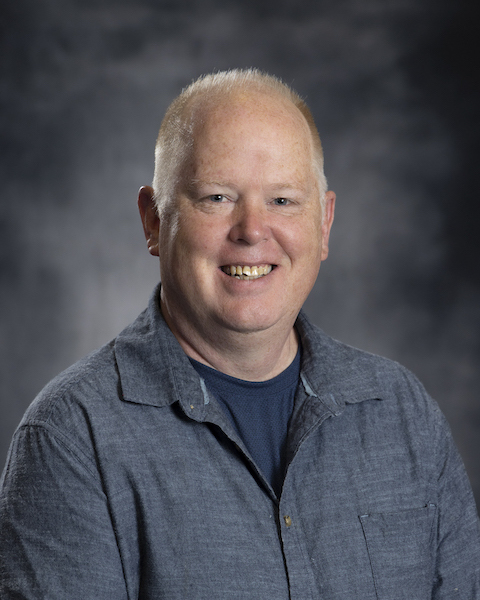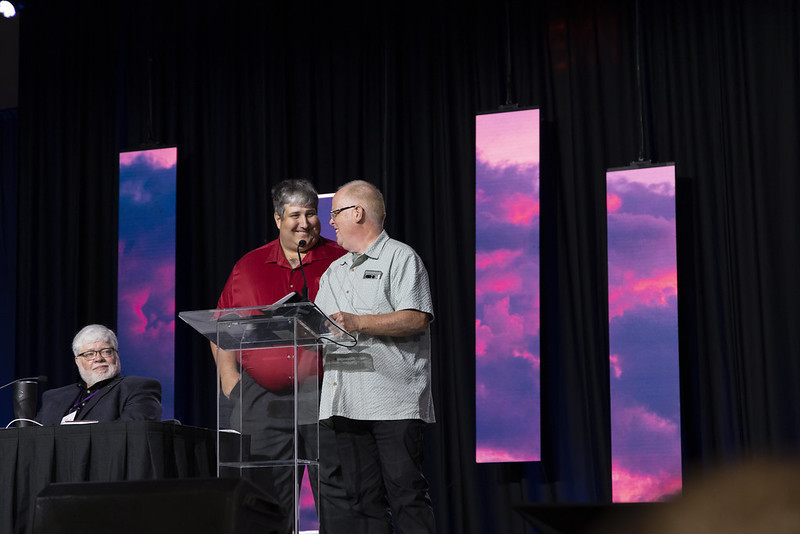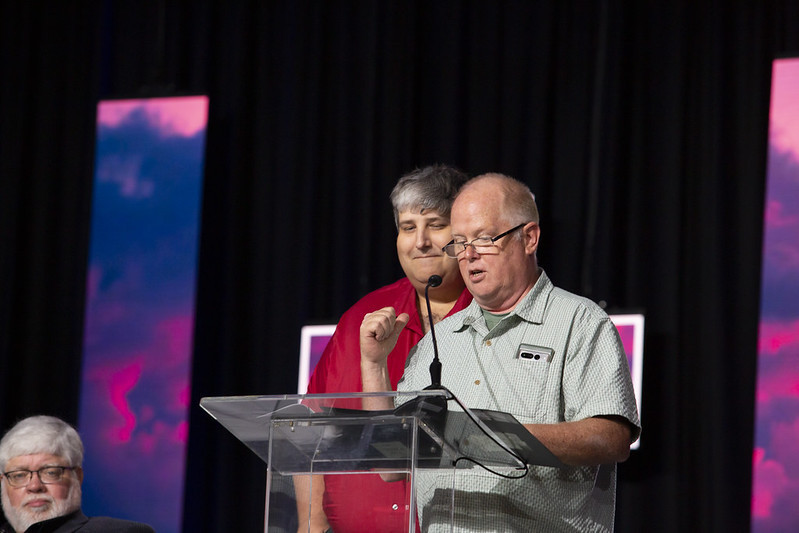
Lay leaders make a difference: John Srstka’s ministry journey
Just sitting in the pew and consuming worship is not an option for John Srstka, Dakotas Conference Co-Lay Leader and a member at Sunnycrest United Methodist Church in Sioux Falls, South Dakota. He is constantly looking for ways to engage others in knowing Christ and digging deeper into being and making disciples.
Through baptism, all Christians are called to a ministry of servanthood. Some feel called to serve their own church or others in a deeper way.
John was baptized a Lutheran, spent his grade school and camp time in a United Church of Christ church, was re-baptized and confirmed as a Catholic, and later married a United Methodist. As he became more active in church, he embraced the Wesleyan theology of The United Methodist Church and found it was the place for him.
“This is a place where I can grow. A place where I can struggle with the doubts and questions of my faith,” said John. “I am surrounded by people that love and support each other.”

John Srstka, Dakotas Conference Co-Lay Leader. Photos by JLynnStudios.
John’s faith journey
“As a child, my mom read the Children’s Bible to me and I got to know the stories of the Bible well,” John remembers. As his family moved around, however, there were a number of different churches and denominations that influenced his faith journey. He recalls sporadically going to Sunday school, and VBS at the local United Church of Christ was his first memory of a church experience. In seventh grade he had moved and was attending Catholic catechism when he noticed his Bible knowledge may have been more complete than the other kids.
“In a time when catholic kids got out of school on Wednesdays for CCD, and protestants stayed for study hall, about seventh and eighth grade, I realized that I had a little more Bible knowledge than the average classmate,” Srstka recalled. “I would ask some questions at CCD, where now I feel bad for the lady leading CCD.”
A turning point for John was coming as he asked faith questions of his teachers and peers.
“I remember specifically the questions that– up to this point it was just ‘Yup, there’s a God because Mom said there was.’ But it was during catechism that the first theological thing hit me. We were being told God knows everything and can do anything, and I asked, ‘If God knows everything, whether I’m going to heaven or hell, then what difference does it make what I do?' A priest then said, ‘Well, God knows, but you don’t know,’ which didn’t help me at all.”
Fast-forward to John’s transition year to college, when John graduated high school, got married, and had a child, all in one year.
“My wife, Cindy, grew up in a United Methodist family steeped in faith. We attended church every Sunday. I was used to that from my time in the Catholic church, where it was mandatory. And I remember thinking, ‘All of this ritual, all of this tradition, what does that really do for me?’”
John acknowledges that Cindy was instrumental in the development of his faith. It had been important for her to marry in The United Methodist Church, and when they later moved, it was important that they look for a local United Methodist church community.
The Srstkas checked out several churches in Sioux Falls, and landed at Sunnycrest UMC when their daughter was ready for Sunday School. “We wound up being invited to help with youth group, which opens you up to leadership, and then more active roles,” John remembers from that transitional time.

Dakotas Conference Co-Lay Leaders John Srstka, right, and Karl Rockeman share a smile while presenting at Annual Conference 2023 in Sioux Falls, SD.
“We joined Sunnycrest UMC when Dana Houck was the pastor. He was the first one to say point blank, at a leadership meeting, ‘Well, this is your church, what do you want to do?’
It was the first time that John realized that he had a responsibility not just for his own faith, but for a whole church, and that, as a lay member, he had an important voice in its life. That was in stark contrast to the various church structures he had grown up with.
“At the time, I was a younger layperson, and I found that there might be a place for me, and Cindy as well. Pastor Dana was like, ‘It’s your call, it’s your church. What do you want to do? I’m just the pastor.’”
Growing in faith
Later, as Walt Geisler and Roy Caudill became the next pastors, John began going to Annual Conference, and taking on more roles. He discovered not only that a United Methodist church is lay-led, but also that he was drawn ever closer to that type of open structure and theology.
“I had transitioned from that tradition and ritual, and I thought that for me, ‘If you’re not careful, that ritual can just become a routine,’ John realized. “I brought lots of traditions and rituals with me from my catholic upbringing, but as soon as they become routine, I’ve gotta bust out of that. It’s very comfortable to slip into that, I can tell you that.”
Pastor Roy Caudill helped John to understand what a disciple does, and what does that look like? He shared how he connected with God to listen and discern, which helped John understand how to listen for God. “Pastor Roy would share, ‘This is what I heard,’ and then he’d turn it over to the leadership team to make the decisions. He would say, ‘Sit with it, pray over it, and how does that fit for you?’”
That personal discipleship grew in John and others in the church. He joined a covenant group and studied using A Guide to Prayer for Ministers and Other Servants, from Bishop Rueben Job and Norman Shawchuck. That book helped connect John to spiritual forefathers in the faith and the Wesleyan tradition, with contemporary writings and historical writings going back centuries. He said that repeating those scriptures and readings over the years always brings some new realizations to light for him.
“What I learned was, every time through [the book’s readings] there was something new because of where I was at in my faith journey, life journey, world journey; a different insight would come from that. That book– and the second one, are tremendous resources as far as naming other books to read, said John. “Through those books, I ventured into more books and authors, including My Utmost for His Highest (Oswald), and The Imitation of Christ (Kempis). So, I’m reading this, and I realized Kempis’ book was written 400 years ago, which reminded me that we’re not all that different today. This stuff that you struggle with, it’s not new. People have been struggling with this for centuries.”
John relflects on high and low points in his faith journey, even a time when he was considering leaving his congregation, when he heard a sermon that helped him realize that he still had a lot left to learn and to share at Sunnycrest UMC. He and Cindy chose to stay and discern what God wanted from them next.
“I don’t know what you want me to do,” John thought, as he was upset with God. “I was going through this list, and I said, ‘I’ve done everything. What do you want me to do?’ And He said, ‘Well, there’s one thing you haven’t spent much time with... praying.’ And I thought, ‘Well praying’s not going to do anything. That’s not DOING something!’ And then the voice went silent.”
So John began paying attention to his prayer life, instead of “just praying for everybody else to get fixed” and found out that if you’re doing it right, you’re not just praying for them, but for your own heart. “For me, I figured out that there’s a difference between ritual and routine.”

John Srstka presents at Annual Conference 2023.
Calling and Serving the church
Through baptism, all Christians are called to a ministry of servanthood. Some feel called to serve their own church or others in a deeper way. John has most often been called to serve out of the needs of the church. John recalled, “Pastor Walt and Dana said, “If you don’t like what’s going on, get involved. Change it; it’s your church.”
“I’ve gotten better at asking questions,” John said. “’Why are we doing that, and why now? Is that what we need? Is that where we’re at?’ It’s not that I’m not on board, but I have my own biases, and the best way to get myself rid of that is to be in a group that is not like-minded, but is like-hearted.”
That is a tenet of Wesleyan structure going back over 200 years to John Wesley and George Whitefield, where Wesley is quoted as saying, “Though we cannot think alike, may we not love alike? May we not be of one heart, though we are not of one opinion?”
As our church and its members move forward in Christian growth, lay leaders need to be like-hearted. John said the leadership team he’s currently part of tries to maintain that perspective. He said, “We might be a little fuzzy on some things, but at the end of the day, we all know we’re trying to come at it [each decision] with the heart of Christ.”
Making disciples
“Up to this point, what I’ve struggled most with, is not having may own clear discipleship journey. But, what I’ve also figured out is that each person that I was with– and not everyone did I agree with right away, but each of those pieces came along and it was what I needed right then.
“At our church we're currently working on developing a more formal process, but my way of doing it is, I know the stuff I’ve read, the scriptures I’ve read, the spiritual forefathers that I’ve read, and how it’s been applied. Most recently it’s been about listening to people, and then, what is it that I can offer you to fit that spot? And not just to say, ‘Here, you need to read this book, because it works for me.’ No, what I’ve tried to be mindful of is, ‘Why am I recommending, whether it’s a book, or a certain scripture?’ They’re all good, but they don’t all apply to the current situation.”
John’s new challenge is, as a disciple, to have at least one or two people he’s working with them to help them come along to at least where he’s at in his faith journey. He can look back to times when a person has been discipling him, but wants to be sure he’s doing the same for others, investing lots of time in them and being there when they need him.
You, like John, are called. The Dakotas Conference invites you to be equipped and inspired to serve as a leader in various ministry areas inside and outside your congregation. Serve as staff or volunteer in areas like community advocacy, social justice issues, earth care, as well as children/youth ministry, congregational care, hospitality, prayer, mission, and more. Contact your local pastor, district superintendent, the Dakotas Conference Lay Leadership Team.
John's abridged book list:
Guide to Prayer for Ministers and Other Servants by Rueben P. Job, Norman Shawchuck
My Utmost for His Highest by Oswald Chambers
The Imitation of Christ by Thomas A. Kempis